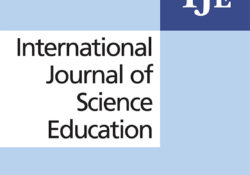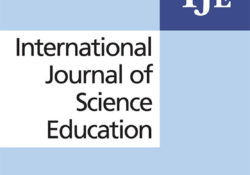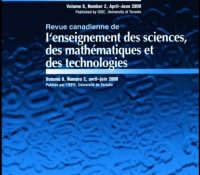
tandfonline.com har udgivet en rapport under søgningen “Teacher Education Mathematics”: ABSTRACT ABSTRACT In this study, the conceptions of pre-university level secondary students with respect to radiation and radioactivity were investigated. A literature review determined what was already known about secondary school students’ conceptions that differ from scientific theory, regarding radiation and radioactivity. Next, 12 Dutch students and their teachers were interviewed. Half of the already known student conceptions were confirmed in the interviews. The most persistent conception was students’ inability to distinguish between irradiation and contamination. All newly discovered conceptions, such as students’ idea that radiation can exist independently of the source of radiation, were discovered within a medical context. A remarkable finding was that students have full confidence in medical professionals, while at the same time they believe that… Continue Reading →
Like this:
Like Loading...
tandfonline.com har udgivet en rapport under søgningen “Teacher Education Mathematics”: ABSTRACT ABSTRACT This paper explores students’ ability to analyse and interpret empirical data as inadequate data analysis skills and understandings may contribute to the renowned disappointing outcomes of practical work in secondary school physics. Selected competences, derived from a collection of leading curricula, are explored through interviews and practical tasks, each consisting of three probes. The 51 students, aged 15 and commencing post-compulsory science education in the Netherlands, were able to carry out basic skills such as collecting data and representing these. In interpreting the data in terms of the investigated phenomenon or situation however, performance was weak. Students often appeared to be unable to identify the crucial features of a given graph. Conclusions based on the data were often… Continue Reading →
Like this:
Like Loading...
tandfonline.com har udgivet en rapport under søgningen “Teacher Education Mathematics”: ABSTRACT ABSTRACT Epistemological and philosophical issues have always been relevant for the foundations of physics, but usually do not find their way into secondary physics classrooms. As an exception to this, the strangeness of quantum physics (QP) naturally evokes philosophical questions, and learners might have to change their ideas about the nature of science (NOS). In this exploratory mixed-method study, we examined possible connections between upper secondary school students’ QP content knowledge and their ideas about relevant aspects of NOS in the context of QP. We administered a QP concept test to 240 Dutch secondary students (age 17–19) after they attended classes on QP without a focus on NOS. Next, we selected 24 students with a range of test scores… Continue Reading →
Like this:
Like Loading...
tandfonline.com har udgivet en rapport under søgningen “Teacher Education Mathematics”: ABSTRACT Formulae display:?Mathematical formulae have been encoded as MathML and are displayed in this HTML version using MathJax in order to improve their display. Uncheck the box to turn MathJax off. This feature requires Javascript. Click on a formula to zoom. ABSTRACT Pre-service physics teachers often do not recognise the relevance for their future career in their university content knowledge courses. A lower perceived relevance can, however, have a negative effect on their motivation and on their academic success. Several intervention studies have been undertaken with the goal to increase this perceived relevance. A previous study shows that conceptual physics problems used in university physics courses are perceived by pre-service physics teachers as more relevant for their future career than… Continue Reading →
Like this:
Like Loading...

tandfonline.com har udgivet en rapport under søgningen “Teacher Education Mathematics”: ABSTRACT ABSTRACT In contemporary laboratory workstations, automation promises a technological fix for producing more robust workflows. By insulating the experiment from tacit or embodied knowledge, it is expected to produce more reliable output. This apparent tension between trustworthy disembodied protocols and the unreliable human factor should not, however, be taken at face value. Instrument operators routinely face uncertainties and instrument opacity, and their concerns may be further aggravated when processes are automated. In some contexts, therefore, researchers cultivate such embodied practices precisely to assure themselves of the reliability of automated instruments and protocols. This qualitative study of research practice in a multi-disciplinary research group in physics and materials science shows that researchers complement instrument readings with ‘somatic vigilance’, a set… Continue Reading →
Like this:
Like Loading...
eric.ed.gov har udgivet: This action research study investigated the impact of teaching physics using a disciplinary literacy framework for instruction across all units in one academic year. Through a suite of vocabulary strategies and lessons that encourage students to write, speak, draw, mathematically translate, and design experiments, students learn to do physics by approximating problems and tasks like physicists. The data from this study suggests that students who exhibit these physicist-like disciplinary literacy behaviors may perform better on math-based assessments so long as they employ disciplinary literacy strategies while problem solving. By teaching via a disciplinary literacy framework, the classroom may become more student-driven where disciplinary literacy behaviors are observable which may result in higher scores on teacher evaluation instruments that favor student-driven instruction. While students that exhibit disciplinary literacy… Continue Reading →
Like this:
Like Loading...
eric.ed.gov har udgivet: The Next Generation Science Standards (NGSS) are an explicit document that articulates our pedagogical practices in K-12 science instruction for the United States. The document is an excellent work that describes pedagogy and road maps for building coherence of science principles and student understanding of the Nature of Science. The prescient thing about the current NGSS is that physics teachers have practiced the ideas and tenets prescribed in the NGSS decades ago. Also, the ideas espoused in the NGSS Framework can easily be transferred to other disciplines, especially Math, through specific, articulated lesson building. Link til kilde
Like this:
Like Loading...
tandfonline.com har udgivet en rapport under søgningen “Teacher Education Mathematics”: ABSTRACT Formulae display:?Mathematical formulae have been encoded as MathML and are displayed in this HTML version using MathJax in order to improve their display. Uncheck the box to turn MathJax off. This feature requires Javascript. Click on a formula to zoom. ABSTRACT The structure and definition of professional knowledge is a continuing focus of science education research. In 2012, a pedagogical content knowledge (PCK) summit was held and it suggested a model of professional knowledge and skill including PCK, which was later often called the Consensus Model (Gess-Newsome, 2015. A model of teacher professional knowledge and skill including PCK: Results of the thinking from the PCK summit. In A. Berry, P. J. Friedrichsen, & J. Loughran (Eds.), Teaching and learning in science series. Re-examining… Continue Reading →
Like this:
Like Loading...

tandfonline.com har udgivet en rapport under søgningen “Teacher Education Mathematics”: Abstract Abstract The study investigated the influence of identity formation on the perceptions and participation of Zimbabwean Advanced Level (A’ Level) female adolescent students in physics. Nine female adolescent students eighteen years and above: three doing mathematics and physics, one doing physics without mathematics and five doing mathematics without physics were purposively selected. The data generating instruments used were semi-structured interview and classroom observation guides as well as document analysis. Findings show that female students associate scientists within a masculine framework in a Eurocentric environment, specifically those scientists who are depicted in their textbooks. The female students doing physics had a positive physics identity which resulted in the formation of positive perceptions towards physics and their participation in the subject.… Continue Reading →
Like this:
Like Loading...
tandfonline.com har udgivet en rapport under søgningen “Teacher Education Mathematics”: ABSTRACT ABSTRACT This article explores how students’ aspirations to study mathematics or physics in post-16 education are associated with their perceptions of their education, their motivations, and the support they feel they received. The analysis is based on the responses of around 10,000 students in England in Year 8 (age 12–13) and then in Year 10 (age 14–15). The students were first surveyed during 2008–2009 and then followed up in 2010–2011. t-tests revealed a decline in their perceptions of their mathematics and physics education. Factor analyses indicated subject-specific constructs that were associated with gender aspiration groups (i.e., high-aspiring girls, high-aspiring boys, low-aspiring girls, low-aspiring boys). High-aspiring girls were more likely than low-aspiring boys to be positive about mathematics/physics education, motivation… Continue Reading →
Like this:
Like Loading...







